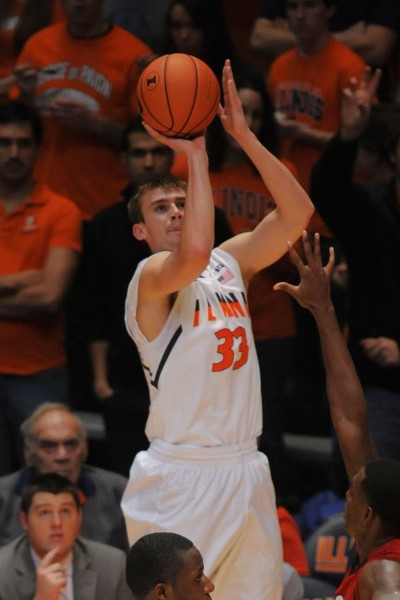Evaluating Key Transfers in the Big Ten: Jon Ekey
Posted by Deepak Jayanti (@dee_b1g) on December 28th, 2013Transferring to another basketball program required a lot of effort until a few years ago when the NCAA relaxed the rules which resulted in a growing flood of transfers. Even after these changes, few players have an immediate impact on their new teams because they have to learn a new system and establish chemistry with players that have already been playing together for a while. Adapting and shaping a role in the lineup of the new team requires a tremendous amount of maturity. Jon Ekey, a 6’7 senior forward for Illinois, is a perfect example of how a player can insert himself into the rotation by identifying the necessary voids and making an immediate contribution. After transferring from Illinois State, Ekey is averaging 9.1 PPG and 6.3 RPG through 12 games with the Illini. The following are two specific aspects of his game that have helped the Illini during the non-conference season.
- Offensive Rebounding: It has been over a year since Meyers Leonard left Illinois for the NBA, but there hasn’t yet been a dominant rebounding forward to fill his shoes. Other than Nnanna Egwu (5.3 RPG), John Groce has not had any forwards who could hold their own on the defensive glass against tough competition. Ekey’s 10.1 percent offensive rebounding rate ranks in the top 10 among Big Ten players, and without his 6.3 RPG this season, the Illini would probably have lost a couple more games so far this season. What’s most impressive about his rebounding ability is his skill at tipping it around in the paint. There is no good statistic to measure tips, but by keeping the ball alive on the offensive end, he provides an opportunity for teammates to pick up loose balls and earn an extra possession. The primary wing players for the Illini – Joseph Bertrand and Rayvonte Rice – average at least 5.0 RPG themselves, which wouldn’t be possible without Ekey’s persistence in keeping the ball alive on the offensive end. Considering that Egwu struggles to stay out of foul trouble, Ekey’s presence on the glass is even more important to keep the Illini from getting dominated underneath.
- Three-point shooting: After losing Brandon Paul and D.J.Richardson to graduation, Groce did not have any guards with soft touch from beyond the arc. Rice and Bertrand prefer to score by cutting to the basket, while Tracy Abrams is not known for his shooting prowess. One could argue that an offense geared around attacking the basket is better than an offense whose focal point is the long-range shot; but most successful college teams still need to have a designated gunner from beyond the arc. After 12 games, it appears that Ekey has become that player for Illinois — he leads the team in three-point makes (27-of-65) and has shot a whopping 42 percent from deep this year. Because of his ability to shoot the three with ease, Groce can afford to run a four-guard lineup when Egwu is sidelined with foul trouble. One of the team’s go-to offensive plays includes Ekey setting a screen for Rice at the top of the key, allowing Rice to get a step on his defender to go to his right, and finishing the play by laying the ball off the glass. If the defense decides to stick with Rice, Ekey is left wide open at the top of the key to nail the jumper. Last season, Tyler Griffey was used in similar sets, but Ekey is more effective because his screens are better and he has a quicker release on his jump shot. Griffey often looked to roll too quickly, seeking his own shot, but Ekey seems to be perfectly fine just setting the screen and letting the guards do the bulk of the scoring instead.












































